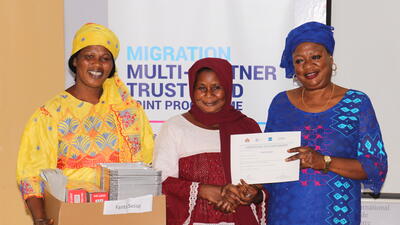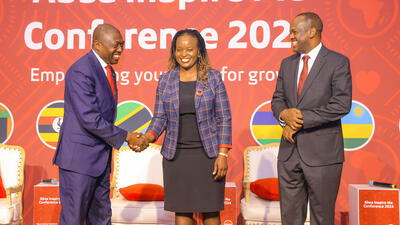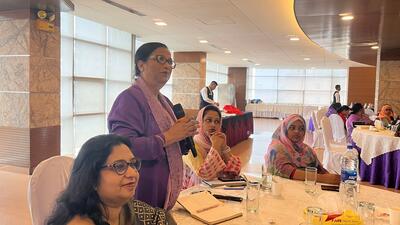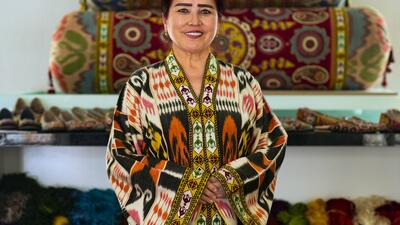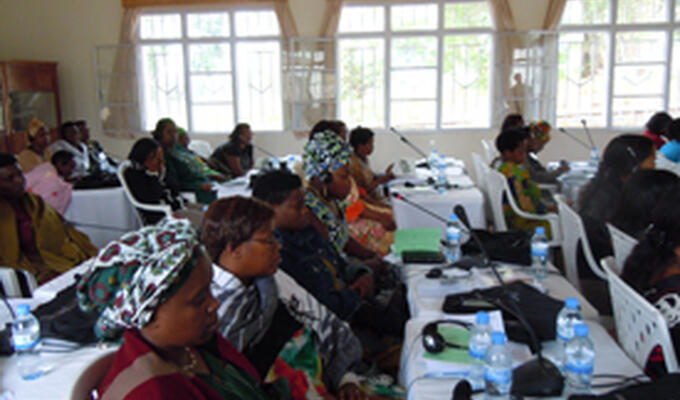


The next stage: A focus on growth
Over the past decade, and even more so in recent years, the numbers of policies and programmes focused on fostering women-owned businesses have risen dramatically. The escalating investment in women’s economic empowerment has come about for two reasons.
First, there is a growing body of research that shows that women are significantly less likely than men to start their own businesses. Annual Global Entrepreneurship Monitor research studies, for example, which have been conducted since 1999, have consistently shown a gap in entrepreneurship rates between women and men in every region and development context. Fact-based information such as this has contributed to the growth in the number of projects focused on the economic empowerment of women.
Second, and more important, there has been a sea-change in the way women’s entrepreneurial activity is viewed — a shift from supporting women’s economic empowerment as a matter of social justice and inclusion toward one of addressing an underutilization of a resource that, if addressed, would yield greater economic growth and prosperity. In the public sector, women’s economic empowerment is firmly in focus in international development agencies and in domestic economic agencies, rather than in gender agencies. In corporations, women’s economic empowerment is in the crosshairs of supplier diversity and marketing departments, as opposed to corporate social responsibility or corporate charitable initiatives.
According to the World Bank’s 2012 World Development Report, Gender Equality and Development, a virtuous circle of transformation is taking place, with ‘impressive gains in women’s rights, educational attainment, health outcomes and labour force participation. Positive feedback loops between gains in these different areas explain why change has been so quick in the developing world. Improvements in one area (higher education) can drive changes in other areas (such as lower fertility [rates] and higher labour force participation).’
While it is still too early in many cases to assess the impact of women-focused economic development programmes in particular, broader evaluation efforts have found that the lives of the women, their families, and their communities have been positively affected. For example, research has found that an improvement in women’s earnings has led to a significant decline in domestic violence in a number of countries. The level of women’s empowerment, decision-making activity and household incomes are also positively correlated.
There are two significant shortcomings to many of these policies and projects, however. First, many policies and programmes focused on women’s economic empowerment do not take into consideration the social context in which women who start and strive to grow their enterprises operate. There are still many legal barriers to women’s economic empowerment (such as ownership of property, inheritance rights, and even occupational limitations); and even when these and other issues are addressed legally, cultural acceptance and progress takes much more time. Thus, women often find it harder to grow their enterprises than do their male counterparts.
What are the main challenges women business owners say they face in growing their businesses? Research conducted by the Center for Women’s Business Research in the United States, and by Womenable and others in other countries over the years consistently finds the following five challenges to be more difficult for women business owners than their male counterparts — especially in developing economy contexts:
1. Access to capital: Women business owners are often constrained in their access to capital by a lack of collateral, or the lack of a credit history.
2. Access to information and technical assistance: While women are now approaching gender parity in education, according to the World Economic Forum’s 2011 Global Gender Gap report, they still lack the managerial experience and knowledge most helpful to entrepreneurial success. Furthermore, women consistently show a much greater interest in entrepreneurial education and training programmes than do men.
3. Access to networks (both formal and informal): Many chambers of commerce or industry groups lack a critical mass of female members, and few have women in positions of power. (Research has shown that only when 20% or more of a group is diverse — ethnically or in terms of gender — do the decisions and actions of the group become more inclusive.) In addition, women are often excluded from the informal conversations that local business leaders have with one another that can lead to new business opportunities. For this reason, encouraging and empowering women’s business associations is an excellent way to increase the strength of women business owners’ networks.
4. Access to markets: The best way to grow a business is to expand the delivery of products and services to new customers, either geographically or by customer type. Women are shown to be consistently less likely than men to engage in international trade, government procurement, or corporate supply chains — three of the best avenues of increasing access to markets.
5. Being taken seriously as a business owner: This issue is harder to assess, and relates to the cultural barriers that many women business owners face in proving their viability as entrepreneurs. For example, in a 2007 study conducted by the International Finance Corporation among women business owners in five countries in the Middle East/North Africa region (Bahrain, Jordan, Lebanon, Tunisia and the United Arab Emirates), between 11% (Tunisia) and 44% (Lebanon) said that being taken seriously as a business owner was harder for them as women.
Are these five key challenges being addressed consistently and adequately? No.
There is an even more significant shortcoming in the thinking and the actions being taken to enable women’s enterprise development in each of these five areas — more important than addressing social constraints as well as legal barriers. Simply put, these programmes are aiming too low. Most programmes and projects targeted at women’s enterprise development are still focused primarily on microenterprise development, microfinance and poverty alleviation. While those efforts are laudable and important, they leave off just when women are setting their sights higher. Therefore, many ‘womenabling’ actions are actually contributing to the lower growth trajectory of many women-owned businesses by helping women get into business without setting them up for successful growth.
How can economic policy stakeholders and women’s empowerment advocates improve the growth and development of women-owned businesses? By supporting the growth of women-owned firms as well. Here are a few organizations that are doing just that:
• Westpac Bank’s Ruby Connection (rubyconnection.com.au), an online community for women entrepreneurs in the Australasia region. Women crave the ability to connect and share with one another, and this is an excellent example of how to foster those connections. The Ruby Connection has a significant presence not only in Australia and New Zealand but also in Oceania, and focuses on access to markets as well as capital. Westpac is one of the founding members of the Global Banking Alliance for Women (www.gbaforwomen.org).
• WEConnect International (www.weconnectinternational.org), which is working to increase the capacity of women-owned businesses to supply their goods and services to multinational corporations. They are active in Europe, South America and Asia — with a key focus in India and China in the coming months.
• And, of course, there is ITC’s Women and Trade programme (www.intracen.org/womenandtrade), which is working with governments and trade organizations to advise them on the benefits of gender inclusion in trade development.
Economic stakeholders (policymakers, economic support organizations and others) should continue to focus on women’s enterprise creation, but widen their lens to create more opportunity for those newly launched women-owned firms to think and grow bigger. They should highlight examples and stories of success, to provide women with role models. And, as Womenable is doing, they should conduct research that educates policymakers, enlightens other stakeholders and empowers women to set their entrepreneurial sights higher.
Here’s to expanding the support of women’s enterprise development to include the growth and scalability of women-owned enterprises as well as women’s enterprise creation. The global economy needs the creative energies of both women and men, so the time is now. And the rewards will be great.








